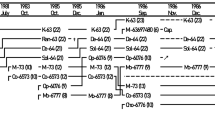Summary
The minoo-B Group has been the subject of our intensive survey for 4 years, and it was revealed that it has a unique character among groups of Japanese macaque, that is, the group has no leader male in true sense, but has a female as a leader. But it is convenient for comparative study that the population of the group is almost the same as that of the Kō-Sima Group.
The discription in this paper is based on the observation in the summer, 1958, when they counted 29, involving 2 males that came from the Minoo-A Group and joined the B Group volantarily. One of these males occupied the first of the rank, but had no important function on social integration.
There were 13 proper members of the group which were over 3 years of age. We found that a rank order was in fine corelation to kinships among them (Tab. 1). They rank in accordance with the order that subsist among families, and only 3 intermediate tranferring cases are witnessed. These 3 cases (in Tab. 1) show all dependent rankings among 13 individuals, that is, they have a firm basic rank which is not interfered by dependent effect. On the other hand, the monkeys under 3 years of age in this group, are under the dependent effect by mothers, and this is the function that make them rank in the basic rank in future.
It is recognized that there are two important principles forming the rank system of the Minoo-B Group. The first of them is that an infant is ranked after its mother's rank, and the second is that, among brothers and sisters, the younger is ranked higher than the older. In a supposed group of pure matriarchy, these two principles are combined and involve a rank system as shown in Fig. 1. But actually there are other factors in the Minoo-B group, such as effect of personality (Buna) and effect of peripherization of young males (Quack, Opal).
Of the two principles found in the Minoo-B Group, the mother's effect is also witnessed in Kō-Sima Group with less importance, but the privilege of the youger one is not confirmed in the latter group yet. On the other hand, there is no serious influence of the high ranked male on ranking of the other monkeys in the former group. These characters of the rank system of the Minoo-B Group, correspond quite well to the characters of other sides of the group organization, and seem to represent a typical matriarchal trend in the Japanese Macaque. But in many groups of it, as we have seen in the Kō-Sima Group, the males of high rank may work to depress the trend in some degree.
The Minoo-B Group has been our object of many researching points at one time, and all those points should be so essencially linked that I am going to discript them in a monograph in future.
Similar content being viewed by others
Author information
Authors and Affiliations
About this article
Cite this article
Kawamura, S. The matriarchal social order in the minoo-B Group. Primates 1, 149–156 (1958). https://doi.org/10.1007/BF01813701
Issue Date:
DOI: https://doi.org/10.1007/BF01813701




